| |
I had been agonizing for weeks over my options: did I, with my unreasonable fear of heights, want to abseil 300 feet into an abyss to explore an underground “Lost World” cave system, or spend the afternoon floating an underground river in Stygian darkness with “worms” dangling overhead? |
|
| |
|
|
| |
| But the choice was made for me. After a comfortable overnight flight out of Los Angeles on Air New Zealand, I rendezvoused with our guide at the Auckland airport, boarded a shuttle for the three hour jaunt south, below Hamilton, to the Waitomo Glow Worm Caves. The “Lost World” tour was already filled so I donned my wetsuit and booties, plopped a headlight-equipped helmet on my head, grabbed an inner tube, and headed for the river. Black Water Rafting’s “Black Labyrinth Tour” it would be. |
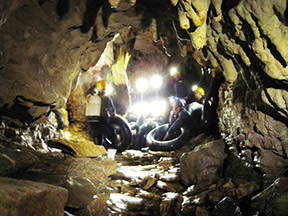 |
|
|
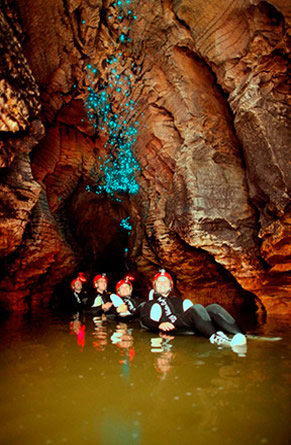 |
|
| |
Making our way through Black Labyrinth Ruakuri Cave to its underground river (Image courtesy Black Water Rafting) |
|
The spectacle emitted by glow worms mimics a heavenly constellation
(Image courtesy Black Water Rafting) |
|
| |
|
|
|
|
| |
Making our way through the first section of Ruakuri Cave by way of bobbing headlamps, dodging limestone stalactites, traversing vaulted galleries and creeping over slippery rocks, we wove our way onward toward our entry point into the underground river. All we had to do was step to the edge of a small rocky platform above a “small” waterfall, which could not be seen in the murkiness of the cave, turn around until our heels hung off into thin air, clutch our tube tightly to our posterior, and jump backwards into the darkness – and hopefully deposit safely into the water. |
|
| |
|
|
| |
|
|
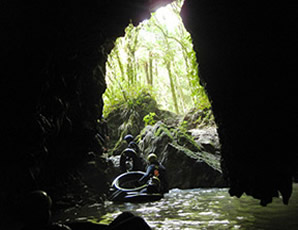 |
|
| |
A short passage requires floating between snug quarters
(Image courtesy Black Water Rafting) |
|
Emerging from the glow worm cave system, we were ready to go again
(Image courtesy Black Water Rafting) |
|
| |
|
|
|
|
| |
This terrifying backwards plunge was thankfully much easier accomplished than anticipated. Once in the river, the atmosphere became hushed and serene. I relaxed, floating along at an unhurried pace, and tried to understand the little creatures decorating the cavern overhead. Glow worms are actually gnat larvae that spin a nest and affix it to a cave ceiling. They drop threads that catch food drifting through, and once prey is ensnared, the threads are pulled up and the meal consumed. The breathtaking bioluminescence display is a byproduct of the larvae’s digestive process.
The effect is magical, if you don’t dwell on the manner of its creation or the type of critters dangling above your upturned face. |
|
| |
|
|
| |
I did not set out to conquer my phobia of heights, but a visit to Skyline Skyrides Rotorua provided an opportunity to challenge myself. To be honest, I was somewhat talked into the Sky Swing by my friends who convinced me it would be great “fun”.
Had I seen it operate beforehand, I’m sure I would have chickened out. But, along with two buddies, I found myself strapped into the seat and hoisted backward, very slowly, up, up, up 165 feet into the air. |
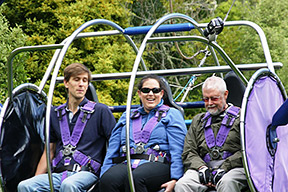 |
|
|
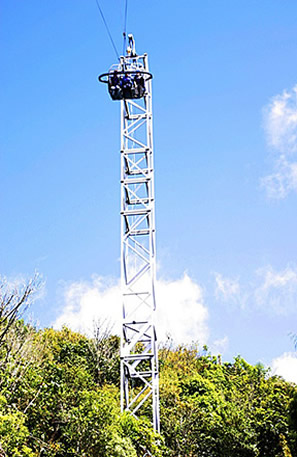 |
|
| |
Having already seen the Sky Swing in action, anticipation runs high. |
|
Rising one-hundred-sixty-five feet skyward seems to take forever. |
|
| |
|
|
|
|
| |
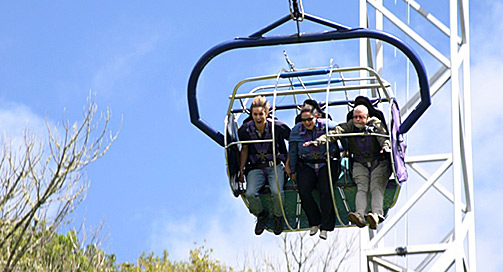
|
|
| |
Ground approach after pulling ripcord: up to 75 miles per hour |
|
| |
But, along with two buddies, I found myself strapped into the seat and hoisted backward, very slowly, up, up, up 165 feet into the air. As our chair gradually tilted forward and time slowed to a crawl, I wanted to scream for the operator to hurry and get us to the top. At last we reached the apex of our climb and the ripcord was pulled that released our ride.
I am not ashamed to admit that I screamed. And so did my two compadres. But by the time we reached the bottom of our first arc, our terror had turned to laughter. As we swung back and forth in slowly decreasing arcs, journeying from hillside out over the edge of Rotorua and back again, we were still laughing. |
|
| |
|
|
| |
Nestled inside Skyline Rotorua’s 8-passenger Doppelmayr Gondola, the ride up the rhododendron-festooned side of Mt. Ngongotaha had provided an unrivaled view of Rotorua, its namesake Lake, and the bucolic countryside surrounding this hotbed of geothermic activity. Unloading at the 1600-foot top terminal, in addition to the Sky Swing you can enjoy a 3D Theatre or head to the Luge tracks. The Cableway Restaurant and Bar offers lunch and dinner buffets from its deck and dining room that are as wonderful as the panorama.
|
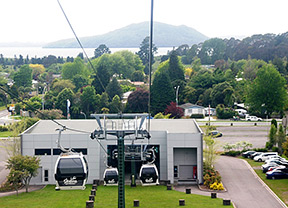 |
|
|
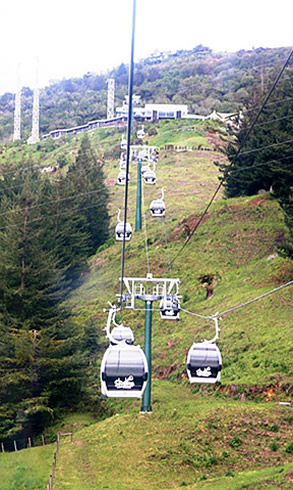 |
|
| |
Mokoia Island rises out of Rotorua Lake seemingly at the foot of Skyline Rotorua’s Gondola. |
|
The 8-passenger Gondola unloads at the 1600-foot level of Mt. Ngongotaha. |
|
| |
|
|
|
|
| |
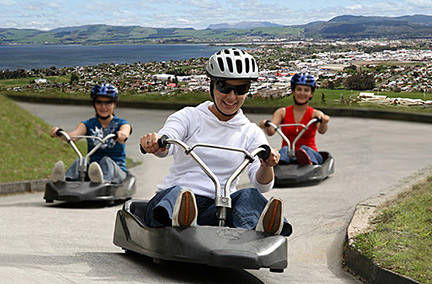
|
|
| |
Skyline Rotorua’s Luge tracks are so much fun, you may forget to slow down and enjoy the view.
(Image courtesy Skyline Rotorua) |
|
| |
Take an Alpine Slide-type cart and replace the runners with three wheels, then aim it down a concrete track wide enough to slalom back and forth and even pass slower riders. Add lush native landscaping and viewpoints wide enough to pull over for photo ops. You have now discovered Skyline Rotorua’s Luge.
Three tracks of differing ability present a variety of chicanes, tunnels, straight-aways, even a bump on the Advanced track that can provide a bit of air. The Scenic and Intermediate tracks, each just over a mile in length, are lit for night riding. All three tracks congregate at the bottom terminal of a chairlift, making it an easy return to the top. An evening run or two followed by dinner in the Cableway Restaurant, the twinkling lights of Rotorua spread like an overturned jewel box below, proves unforgettable. |
|
| |
|
|
| |
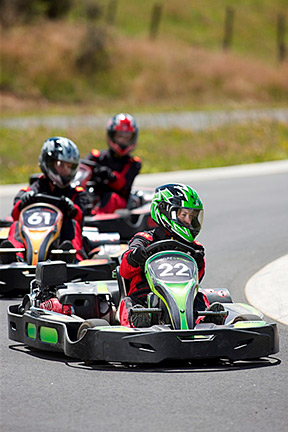 |
|
Climbing into my racing suit at Off Road NZ’s Raceline Karting, I felt a bit pretentious. Buckling my helmet and pulling on gloves seemed to complete the façade. But once I was speeding along the track in my 390cc Sodi Kart, the possibilities of what it could do made my adrenalin surge and I almost felt like a real race driver.
The three-quarter-mile track was wet from an earlier shower, and I was only vaguely aware of the other racers. It was just me testing how long I could keep pedal-to-the-metal before a last minute controlled brake as I headed into the curves, how quickly I could accelerate out of the corners, and if my rear tires broke loose ever so slightly, so much the better.
The 4-stroke Sodi Karts at Off Road NZ Raceline Karting can reach speeds over 60 mph on the longest straightaway (492 feet). (Image courtesy Off Road NZ) |
|
| |
|
|
|
|
| |
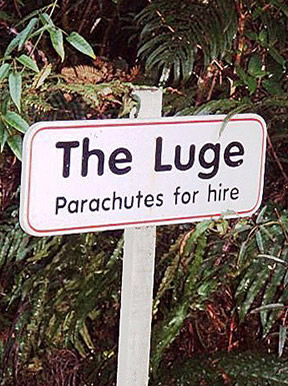 |
|
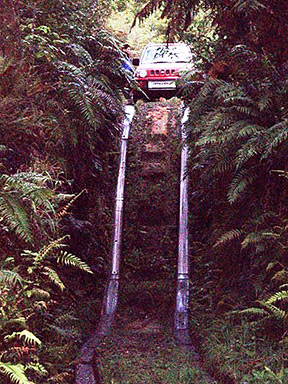 |
|
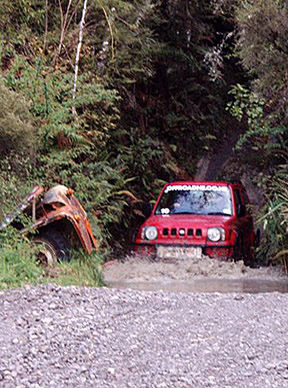 |
|
| |
Off Road NZ’s sense of humor doesn’t quell the nerves as you approach the 20-foot drop on the 4WD Bush Safari. |
|
Hold on tight as you tackle the 80-degree slope of The Luge. |
|
Water passages are accomplished driving across log bridges and through stream beds. |
|
| |
|
|
|
|
|
|
| |
A very different type of motorized thrill awaited me on Off Road NZ’s 4WD Bush Safari. Pairing up to drive the Suzuki Jimnys, my partner tackled log bridges, steep climbs, and deep muddy water holes. A tad bit mundane for me, whose backcountry trips often included my husband finding it great fun to compare how my Toyota 4Runner managed the same hillclimbs our snowmobiles undertook in the winter and our dirt bikes snarled up in the summer.
Fate had her snares laid for me when, hidden among tight twisting curves, my turn behind the wheel included the Roll Me Over, where passage requires the tires on one side to grip high along a steep wall and you are convinced you will, indeed, roll over. And the there was The Luge.
What can I say about the daunting prospect of facing a 20-foot near freefall down an 80-degree slope? A sign at the top, letting you know parachutes are available, attempts to quell your fear with humor. Another sign at the bottom tells of fresh undies for sale at the office (humor or fact?). In between lies a piece of terrain that somewhat terrified me. But with gentle coaxing from our guide, who walks alongside the group and is in constant communication via two-way radios, I held my breath and let the little Suzuki drop over the edge. I’m not sure if my eyes were open or closed, but I do remember the explosive “yahoo” I gave when we leveled out at the bottom. |
|
| |
|
|
| |
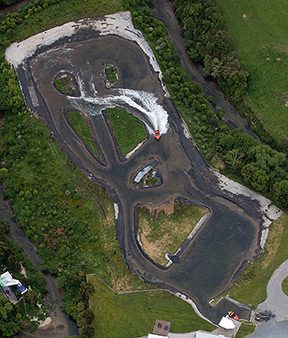 |
|
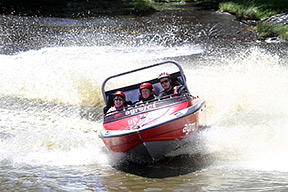
At Agroventures I was able to sample excitement on the water, in the air, and on a track. Three laps around the Agrojet watercourse in jet boats that can accelerate to 62 mph in 4.5 seconds provided wet thrills as we maneuvered sideways at the last possible moment to steer our way through the maze of man-made islands, finishing with a 360-degree spin.
|
|
| |
The Agrojet course, punctuated with tiny islands, creates a high-octane ride.
(Images courtesy Agroventures |
|
| |
|
|
| |
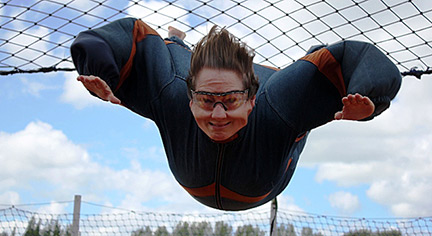
|
|
| |
After a few clumsy flounders and flubs, I found myself actually flying. (Image courtesy Agroventures) |
|
| |
|
|
| |
I didn’t think my acrophobia would mind me levitating a mere six feet, so I headed to Agroventures’ Freefall Xtreme for a bit of body flying. Decked out in another set of adventure attire, this time a “flying suit”, I gave in to the 112 mph winds generated by twin turbo Detroit diesel V12 engines. After some assistance to get the feel of how legs, arms and head should be positioned, I realized I actually could fly! For a few seconds, at least. |
|
| |
The recumbent position makes pedaling the Shweeb effortless, and Agroventures in Rotorua is the only place in the world you can try it out. (Images courtesy Shweeb) |
|
| |
|
|
| |
Not truly ground-based nor really an aerial contraption, the Shweeb defies description. Meaning “hang” or “suspend” in German, individual enclosed capsules dangle from an overhead track stretching 656 feet across scenic New Zealand farmland. As you pedal, reaching speeds up to 28 mph, you sway through corners and curves, rising and falling with the undulating rail. I was amazed at its smoothness and speed. Google must be, too, since they have invested big bucks into researching how to adapt the Shweeb into a human-powered mass-transit system. |
|
| |
|
|
| |
Tumbling and tossing my way down ZORB Rotorua’s Zig-Zag course (Images courtesy Zorb Rotorua) |
|
| |
|
|
| |
Flap unsealed at the bottom, I can extract my drenched and disheveled self. (Images courtesy Zorb Rotorua) |
|
| |
|
|
| |
I can’t explain the fascination that arose the first time I saw a picture of someone playing human hamster, tumbling down a slope inside a gigantic double-sectioned flexible plastic ball. Rotorua gave me the chance to experience a ZORB for myself after years of wondering what tumbling head-over-hinny was all about. And there’s a wet ZORB option?
First I had to select my track. The smooth, gentle slope straight down the hill looked too humdrum. The Drop started as described but quickly mellowed into another pedestrian path. But off to the side coiled the Zig-Zag track, twisting its way down the hill in crazy curves and high banks. Heck, if I’m going to do it, I might as well do it full bore, no? A few gallons of bath-temperature water was added to the interior cavity and I dove head-first through the tunnel-like entrance, landing with a splash.
There was a brief moment of panic when the flap was secured, meant to contain both water and rider, and after a few errant ducks were shooed from the track, I was rolled off the launch platform. It was an odd experience to roll uncontrollably this way and that, side to side, head up, head down, water sloshing about. Finally I came to rest, an attendant opened the flap, and I scrambled unceremoniously back into the “outside” world.
Having survived the washer-dousing/dryer-tumbling ZORB ride, the certainty of being drenched and the prospect of plummeting over a waterfall on my next adventure didn’t seem the least bit unusual for this trip. |
|
| |
|
|
| |
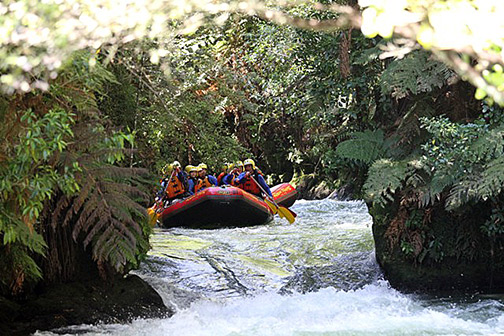
|
|
| |
Rated a Class V river, the Kaituna includes a variety of small drops and waterfalls. (Image courtesy River Rats) |
|
| |
Paddle, paddle, paddle… BACK paddle! BACK paddle! HOLD!! As I strain to keep up with our guide John’s instructions, I blink furiously to see through the wall of water slapping me in the face. I had purposely picked a seat mid-raft to lessen this sort of baptism by the Class V Kaituna River, but for some masochistic reason John moved me to a front seat. So here I was, struggling to set a rhythmic tempo the paddlers behind me could follow.
I had been nervously anticipating today’s adventure: going over the world’s tallest commercially rafted waterfall, 23-foot Tutea Falls. Now I’m clad in the River Rats version of yet another set of adventure wear: fleece shirt, wet suit, booties, helmet, and the thickest life vest I have ever encountered. If needed, I certainly hope it will do the job because I don’t think I can move enough to swim. |
|
| |
|
|
| |
Taking on the Kaituna River’s 23-foot Tutea Falls (Images courtesy River Rats) |
|
| |
|
|
| |
As we alternated among floating, paddling, and dropping over small falls, with each plunge we knew we were getting closer to Tutea. If we fell out of the raft going over the monster, we were to curl into a ball so we’d pop back to the surface faster under the pounding cascade. When asked if many rafts overturn, John tried to dispel our fears saying, “Most make it.”
There are eight rafts in our “herd” floating the river. Our group fills two of them and the others are a United Nations of nationalities. We congregate, a couple of rafts at a time, above Tutera, and one by one our guides line us up. Two quick strokes forward, clutch paddle tight to the side of the raft, and hang on for dear life. |
|
| |
|
|
| |
Our guide manages a headstand before “exiting” our raft. (Image courtesy River Rats) |
|
A moment of reflection and gratefulness for having arrived unscathed at the bottom of Tutea Falls (Image courtesy River Rats) |
|
| |
|
|
|
|
| |
Some rafts land hard to starboard, others veer to port. One unfortunate group rises from the churning whitewater upside down, paddlers and guide scattered around their overturned conveyance. The rest are luckier and stay upright after the plunge, including our group. As we began to loudly congratulate ourselves, we realize we’ve lost John. Fortunately the River Rats’ photographer, stationed below the falls to capture the action, had the proof of what happened. Our guide and our raft parted ways going over the falls, but not before John executed a nearly perfect headstand in the back of the boat! |
|
| |
|
|
| |
The Princes Gate Hotel offers 34 beautifully furnished rooms. (Image courtesy Princes Gate Hotel) |
|
The Princes Gate Arches, erected in 1901 to honor a visit from the future King George V and Queen Mary, mark the entryway to Government Gardens. |
|
| |
|
|
|
|
| |
A peaceful place to recoup from a day of heart-thumping adventure is the Princes Gate Hotel, which has its own tale of adventure. Built in the town of Waihi in 1897, business boomed for the New Central Hotel, as it was known. Third largest hotel in New Zealand, and its first private one, business fell off after the town voted in prohibition. The hotel served as a hospital during the post-WWI influenza epidemic, but was torn down shortly afterward and transported by rail some 40 miles south, to Rotorua, where it was reconstructed.
Today this stately and graceful Victorian structure overlooks the Government Gardens. The Hotel interior is decorated with gleaming wood and leather furniture, thick carpets and sparkling chandeliers (including one in my bedroom). Two restaurants, a bar, Cabaret dinner shows, and High Tea mean the visitor need not venture far for food or libation. And any day’s itinerary can benefit from an evening soak in the thermally-heated pools. |
|
| |
|
|
| |
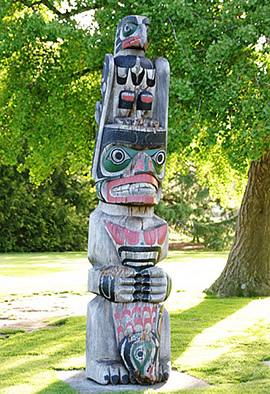 |
|
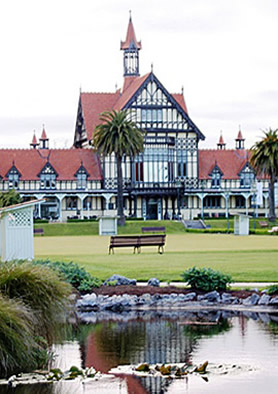 |
|
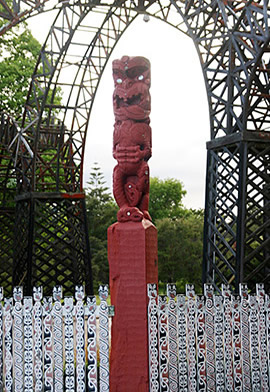 |
|
| |
Government Gardens holds surprises like this Totem Pole, created by a First Nations master carver in British Columbia and a gift from the Canadian government. |
|
Originally built as the Government Bath House, this Dutch Colonial-style building now houses an amazing Museum and Art Gallery. |
|
Totara carvings welcome visitors to Government Gardens and act as kaitiaka, or guardians, of the grounds. |
|
| |
|
|
|
|
|
|
| |
|
Waterfowl and seaplanes share the waters of Lake Rotorua. |
|
|
|
|
|


